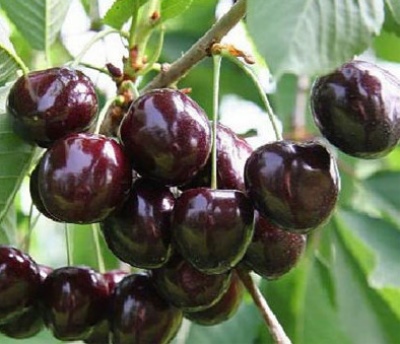
- Fruit shape: round and wide heart
- Authors: Pavlovsk experimental station VIR (St. Petersburg)
- Growth type: medium-sized
- Appointment: for fresh consumption
- Yield: high
- Tree height, m: 3-4
- Crown: compact
- Fruit size: medium
- Fruit weight, g: 3-3,5
- Fruit color: dark cherry, almost black when fully ripe
Cherry Leningradskaya black is a popular variety, one of the few adapted for growing in temperate climatic zones. Fruit trees delight with their vitality, quick entry into fruiting. Cherries of this variety are very tasty, they have time to ripen even in the absence of a large number of sunny days.
Breeding history
The variety was bred at the Pavlovsk experimental station of the VIR in St. Petersburg. The breeders set a difficult task to obtain a cold-resistant plant that can bear fruit in the climate of the northern regions. FK Teterev became the author of the variety.
Description of the variety
The tree is medium-sized, 3-4 m high, with a compact but wide crown. The foliage is moderate, the leaf plates are oval. Inflorescences are racemose, uniting 3-5 buds. The crown is rapidly gaining growth, in 1 year it can be up to 1 m. Fruit buds of the Leningrad black cherry tree come out of dormancy later than in other varieties.
Fruit characteristics
Fruits are medium in size, each weighing on average 3–3.5 g. They are heterogeneous in shape, may be wide-hearted or more rounded. The skin first turns dark cherry color, then becomes almost black. The pulp is a deep red hue, it contains a poorly detachable medium-sized bone.
Taste qualities
Cherry of this variety is very sweet, with a subtle tinge of sourness and light spicy undertones. The fruits receive a tasting score in the range of 4-4.2 points. The consistency of the pulp is soft, with fibers, the taste is juicy, table-like. Fresh fruits are especially good; they are usually not left for processing.
Ripening and fruiting
In the period of bearing fruit, the tree begins 3 years after planting. Fruit ripening occurs at different times, stretching from 2 half of July to mid-September.

Yield
High. 30-40 kg of fruits are harvested from the tree per season.
Growing regions
The variety is perfectly adapted to the conditions of the Non-Black Earth Region, zoned for the North-West regions. There is experience of its cultivation in Karelia and adjacent regions.
Self-fertility and the need for pollinators
Leningradskaya black belongs to the self-fruitless varieties of sweet cherries. Pollinators must be present in the garden. Cherry trees of the varieties Iput, Bryanskaya rozovaya, Revna, Tyutchevka, Ovstuzhenka are considered the best. Also, Leningrad yellow and Leningrad pink are suitable as pollinators.
Growing and caring
For the successful cultivation of cherries of this variety, it is necessary to prepare an appropriate site. The best choice would be a well-lit place, far from lowlands, high groundwater. A western or southern slope is suitable, which shelters the fruit tree from strong winds.The seedlings are transferred to the ground in the spring, as well as in the fall, until mid-October.
When choosing a place, it is important to maintain a distance of at least 4–5 m from other plantings and buildings. Mixed plantings for this cherry are undesirable. The soil should be loose, breathable, loamy or sandy loam. With a dense layer of clay below, drainage is placed in the pit during planting.
Leningrad black will have to be watered no more than 3 times during the season. The first charge of moisture is given upon awakening the buds, but before flowering. The tree is then watered 2 weeks before the expected harvest. The third introduction of moisture occurs at the end of the leaf fall. Pour 20 liters of water under each plant.
Top dressing also requires adherence to a schedule. The first is carried out in May using urea, superphosphate, potassium salt. After harvesting, a second feeding is carried out. Complexes based on potassium and phosphorus are used. Also, trees after leaf fall will need pruning.




Disease and pest resistance
The variety is resistant to the most common diseases of fruit trees. Leningrad black in thickened orchards can become infected with cherry fly, leaf roll, tubevert beetle, sawflies, aphids. During the ripening period, ripe fruits attract a large number of birds. It is important to take care in advance that the berries are inaccessible for pecking, protect them with nets.
From fungal diseases, the variety can suffer from coccomycosis, moniliosis. In such cases, fungicidal treatment helps.

Requirements for soil and climatic conditions
Leningrad black - winter-hardy sweet cherry. It is perfectly adapted to temperatures down to -30 °, it is not afraid of spring frosts. The variety is resistant to drought, it needs abundant watering only during flowering and before the stage of coloring the fruits.In spring, trunks may need protection from sunburn.

Review overview
According to summer residents, Leningrad Black is a time-tested variety that should definitely be started in the garden. It is noted that these trees do not care about frosts and strong winds, and the absence of a hot summer only slightly affects the yield and size of berries. Also, summer residents praise the Leningrad Black for the rapid onset of fruiting, it will take only 3 years to wait for signal fruits, and then the volume of collections will only grow.
There are also disadvantages. In extreme heat, the trunk can erode, crack, burns negatively affect the general condition of the tree. There are also dissatisfied with the size of the fruits.
Among other disadvantages, gardeners highlight the need to protect the ripening crop from birds, otherwise it will not work to wait for full ripening. The need to plant pollinators is also considered a disadvantage. Without them, the tree will yield no more than 1–2 kg of berries.































































